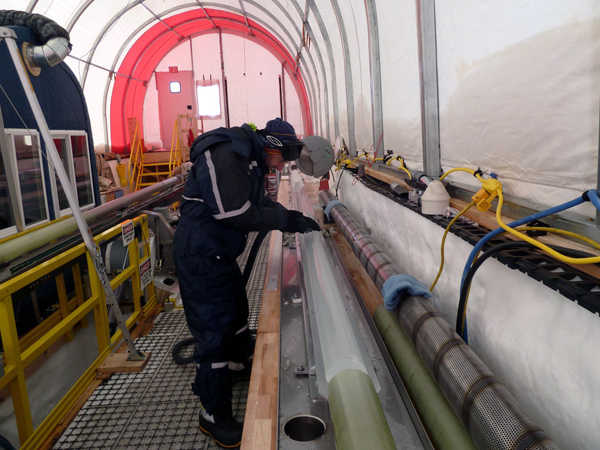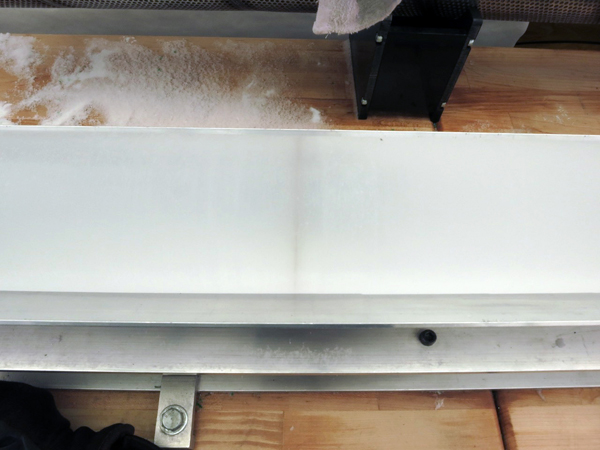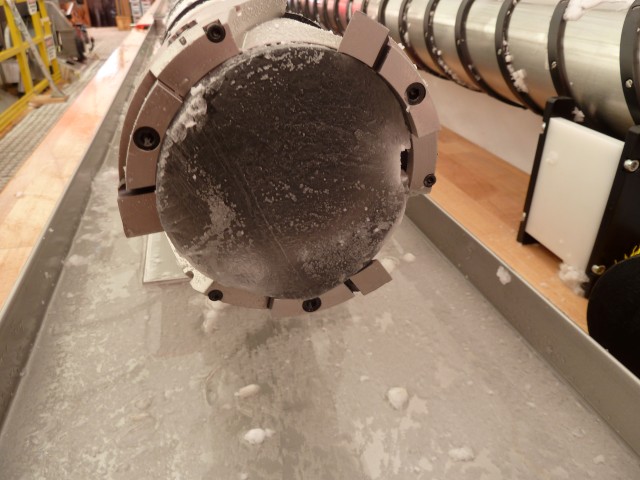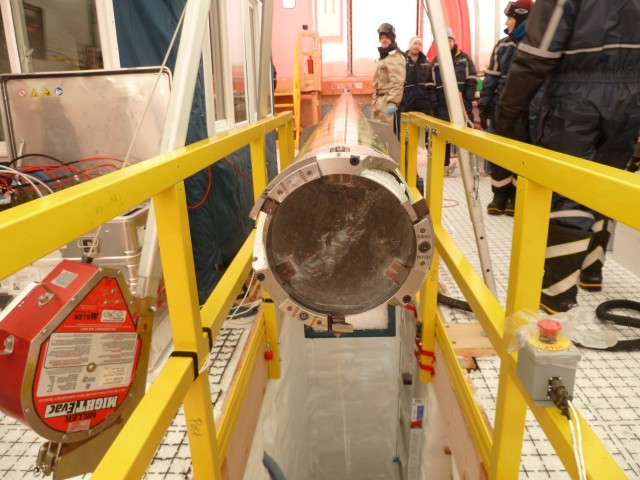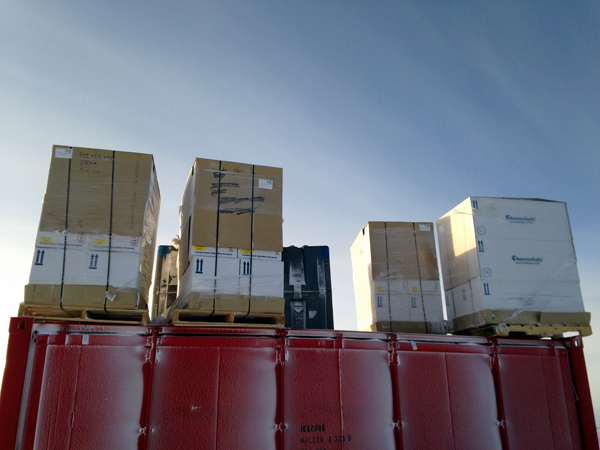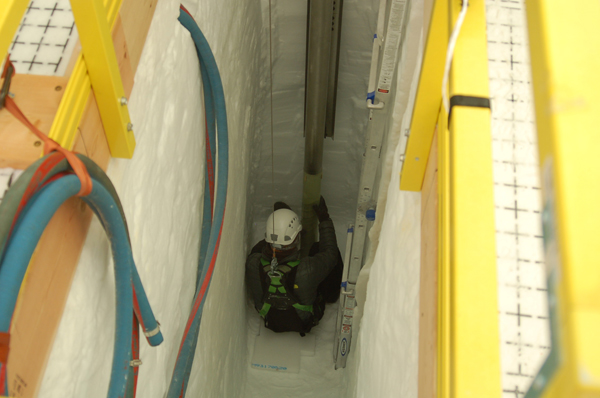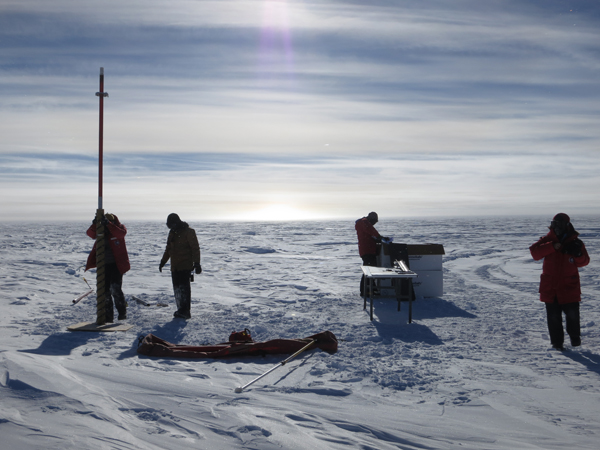News
Field Updates
Below is an archive of ~weekly updates from the Antarctic field seasons.
2016/17 Antarctica
December 13, 2016
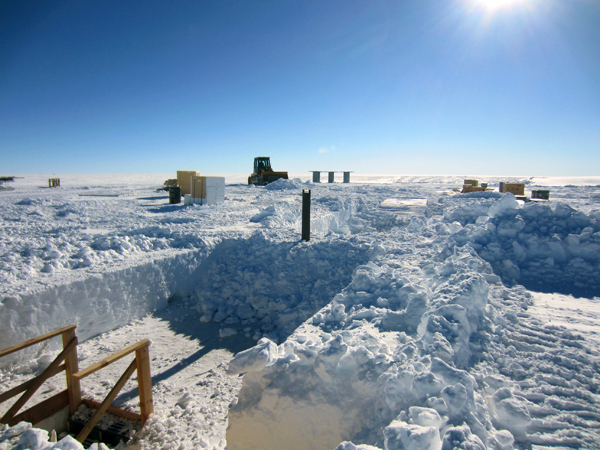
The drill trench after the drill tent has been removed. The extended borehole casing is in the center of the picture. Credit: Joe Souney
Camp shut-down has been successfully completed. As of Monday, 12-Dec, the entire South Pole Ice Core camp was packed up, the borehole casing was extended about 4-feet above the surface, and most of the trench backfilled with snow.
Everyone except Emma has flown to McMurdo on a 13-Dec PAX flight. Emma is scheduled to fly with the cold-deck later in the day and arrive to McMurdo very early on 14-Dec.
The camp has been closed and all I-164-S cargo is packed and ready for retro, sitting in the cargo line of South Pole Station.
The second cold-deck did not happen this week. A cold-deck was planned first for 09-Dec and then for 12-Dec but both got canceled. There is a good chance it will happen on a late night flight on 13-Dec. [Update: the cold-deck was successfully completed; the cold-deck arrived to McMurdo around 05:00 on 14-Dec. Emma Kahle escorted the ice on the cold-deck flight.]
The dust log by Ryan Bay (I-194-S) has been successfully completed (2 trips). The IDDO camera has also been successfully deployed down the borehole.
Weather has been good at South Pole this past week. Temperatures were in the -25 C to -29 C range this past week. Everyone is in good health.
December 5, 2016
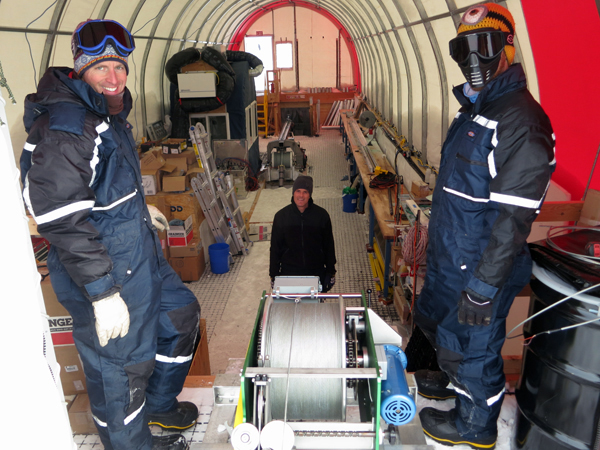
Jay Johnson, Ryan Bay, and Josh Goetz prepare to lower the Intermediate Depth Logging Winch into the drill tent in preparation for borehole dust logging. Credit: Murat Aydin
South Pole Station had a lot of visitors this past week. Antarctic Sciences Section Head Eric Saltzman and Science Assistant Colene Haffke from NSF arrived on Monday, 28-Nov. They visited the SPICECORE site in the afternoon. A group from the National Science Advisory Board arrived on Tuesday, 29-Nov, and they were accompanied by Polar Division Director Kelly Falkner, Antarctic Infrastructure Section Head Scott Borg, and Antarctic Earth Sciences Program Director Thom Wilch from NSF in addition to Eric Saltzman who was already at the station. The group was at the Pole for only a couple of hours. They received a science briefing in the science laboratory at the station that included a short SPICECORE presentation. We also had an ice core display for the group to see at the station entrance.
There was a SPICECORE science lecture on Sunday, 04-Dec. The lecture was primarily an overview of preliminary data that have been generated over the last year and it was very well received.
Logging and packing of the brittle ice (tubes 735 through 1077) ended today on 05-Dec. Tube #1077 was the last meter we packed. There are currently 69 ISC boxes in the trench waiting for the 2nd cold deck of the season, which we hope will happen sometime from 07-Dec through 09-Dec. The 69th ISC box has only 3 meters of ice.
The first cold deck of the season happened around noon on Friday, 02-Dec. This shipment included all the ductile ice left at South Pole from last year. The shipment was 2 AFPs worth, however, one of the AFPs had only 3 skids and one of those skids had only 7 seven boxes.
Ryan Bay from the SPICECORE affiliated project I-194-S arrived on Tuesday, 29-Nov.
Temperature logging of the SPICECORE borehole was completed by Ryan Bay, using the IDD winch. Two different tools were used and temperatures were logged going down and also up. Up next is the dust log under I-194-S. The dust log will be done with the IDDO Intermediate Depth Logging Winch.
Weather has been good at South Pole this past week. Temperatures were in the -24C to -31C range this past week. The drill trench was -22 to -26C while we were processing ice. Everyone is in good health.
November 27, 2016
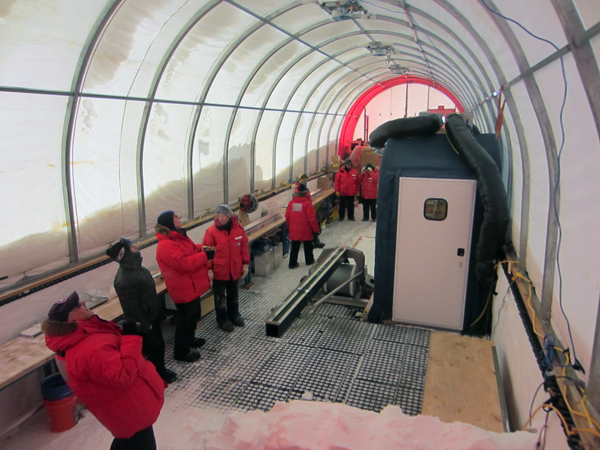
Scott Borg (Antarctic Infrastructure and Logistics Section Head), Vladimir Papitashvili (Antarctic Astrophysics and Geospace Sciences Program Director and NSF South Pole Science Representative), Bill Coughran (summer site manager), and Wayne White (Winter site manager) tour the South Pole Ice Core field site. Credit: Joe Souney
3 science members (Murat Aydin, Joe Souney, Emma Kahle) and 2 drillers (Jay Johnson and Josh Goetz) arrived at the South Pole on Wednesday Nov. 23rd.
The first real work day at the drill site was Thursday Nov. 24th. Most of the day was spent on setting up and organizing the camp. Scott Borg, Antarctic Infrastructure and Logistics Section Head, and Vladimir Papitashvili, Antarctic Astrophysics and Geospace Sciences Program Director (and NSF South Pole Science Representative), toured the SPICECORE site in the afternoon. They were accompanied by South Pole station summer manager Bill Coughran, South Pole station winter manager Wayne White, and our ASC program manager Leah Street.
All cargo needed to start the season is at the Pole. We are waiting for the critical cargo that we will need for borehole logging.
Ductile ice from last year has been moved out of the storage trench on Friday Nov. 25th. It took us about 5 hours to move 55 ISC boxes, including the time spent on preparations. The boxes took up 2 AFPs. One of the AFPs has only 7 skids (normally 8 skids) and one of the skids has only 7 boxes (1 less than normal). Both AFPs are on a sled parked under the arches waiting for the first cold deck of the season. We will wait for McMurdo freezers to be ready before calling for a cold deck.
Logging and packing of the brittle ice started on Sunday Nov. 27th after lunch. We logged 20 m of ice (736 - 756 m) during the first afternoon session.
South Pole temperatures have been in the -28 C to -32 C (-35 C to -45 C wind chill) range since our arrival. Everyone is in good health.
November 20, 2016
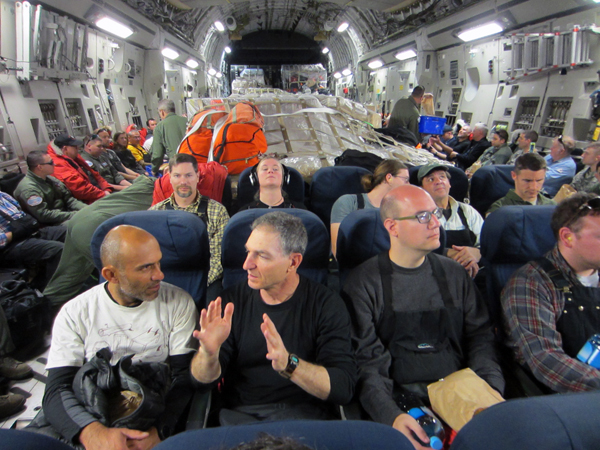
View of the inside of the C-17 aircraft during the flight from Christchurch, New Zealand, to McMurdo Station, Antarctica. Murat Aydin (left; South Pole Ice Core Chief Scientist) talks with Eric Saltzman (center; Section Head, Antarctic Sciences, NSF) Credit: Joe Souney
The field season has started. There has not been any real field activity since we have not yet arrived at the South Pole.
3 science members (Murat Aydin, Joe Souney, Emma Kahle) and 2 drillers (Jay Johnson and Josh Goetz) arrived at Christchurch, NZ on Nov. 17th and arrived at McMurdo, Antarctica on Nov. 19th. We are scheduled to fly to South Pole station Antarctica on Nov. 21st on the 9th mission of the season to South Pole this year.
We picked up data loggers from ASC science cargo to hand carry on the fight to the Pole.
The outside temperature in McMurdo is -10 degrees C today. There is light snow in McMurdo. Everyone is in good health.
2015/16 Antarctica
January 24, 2016
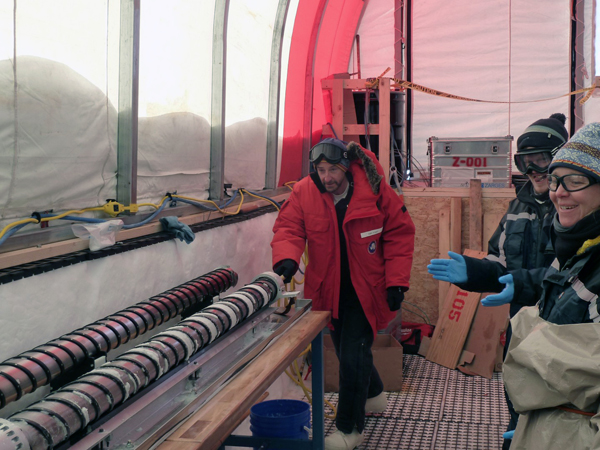
Eric Steig pushes the last core (from 1751 meters depth) out of the drill barrel. Photo credit: Jay Johnson
We have great news to report: drilling of the South Pole ice core is now complete, with a final depth of 1,751 meters!
We continued drilling 24 hours per day this past week. Drilling was officially completed on Saturday, 23-Jan, at about 6:00pm local time (at 1,751 meters depth). The drill gave us one final fight Friday as we again experienced problems with the control system. Thanks to Zach, we were able to get back running so we could end the season on our terms, reaching our (new) goal of 1750 meters.
We drilled excellent-quality ice throughout the week, with very clean drill/core breaks. We identified one cloudy layer since the last report, at 1694.88 meters depth; it was slightly inclined at ~9° from horizontal. Many of the core breaks since then have been at about the same angle.
The deadline for getting cargo to McMurdo Station for subsequent vessel retrograde to the USA has already passed. Therefore, all of the most recently drilled ductile ice will stay in the storage trench for the winter (it is already packed in core tubes and ISC boxes). The core storage trench now contains the most recently drilled ductile ice (tubes 1478-1750, in boxes #81-135), and the remaining brittle ice (tubes 736-1077) that we drilled at the very beginning of the field season. This means we have four (4) Air Force pallets of ISC boxes (~117 ISC boxes) to ship out from South Pole next season.
Outside temperatures have been in the -29°C to -31°C range, with somewhat more persistent winds (~12 knots) than usual since before the New Year began. Conditions have been mostly clear, with some clouds on the horizon in the direction of the Amundsen Sea. The drill tent has seen a range of temperatures from -22°C to -25°C. The core storage trench has warmed up a little but still remains below -31°C.
This week's activities will involve baling chips from the borehole, bringing the borehole casing up above the snow surface, backfilling the drill trench, and packing up the drill (but leaving the winch and 1900 meter cable for borehole logging next year). Everyone is scheduled to depart South Pole on Friday, 29-Jan.
Everyone continues to be in good health.
January 17, 2016
Drilling progress remained excellent through most of last week, with a depth of 1608 meters reached on 14-Jan. Progress was slowed after a control box and motor failure, probably attributable to our having switched generators on 13-Jan (see Jay Johnson's SITREP for more information). We spent most of 14-16 Jan bailing chips that the drill leaves behind from the borehole, while motor sections were checked and/or repaired. Drilling resumed the evening of 17-Jan and a depth of 1619.930 meters was reached at the end of the night shift on the morning of 18-Jan.
We are continuing to drill excellent-quality ice. A few runs this week were short (1 to 1.5 meters in length, as opposed to the normal 2 meters) owing to the chips in the borehole, so that there are a few tubes with two ~0.5 meter sections. In general, we are continuing to pack continuous 1 meter cores with only very occasional mid-tube breaks or core-end chips.
As of the morning of 18-Jan we have 30 boxes stored in the trench (box # 81-110), in addition to the brittle ice drilled this season.
Ice was shipped to McMurdo on a night flight on 16-Jan. All ice to be shipped this season is now at McMurdo Station inside the SafeCore freezer container. See last week's report for details.
The weather has continued to be very nice, generally calm and sunny. Visibility has occasionally been moderate, but only for short periods. Outside temperatures have been in the -25°C to -29°C range, though we have seen a few very warm days near -20°C, and as warm as -18°C. The drill tent has seen a range of temperatures from -19°C to -23°C but has not been persistently above -20°C during any core logging. The core storage trench is close to -33°C.
This coming week will be our last week of drilling and we are still on track to finish at around 1,750 meters depth.
Everyone continues to be in good health.
John Fegyveresi ran a 50-mile ultramarathon last week. As far as anyone is aware, this is the first time in history that anyone has done this at the South Pole.
January 10, 2016
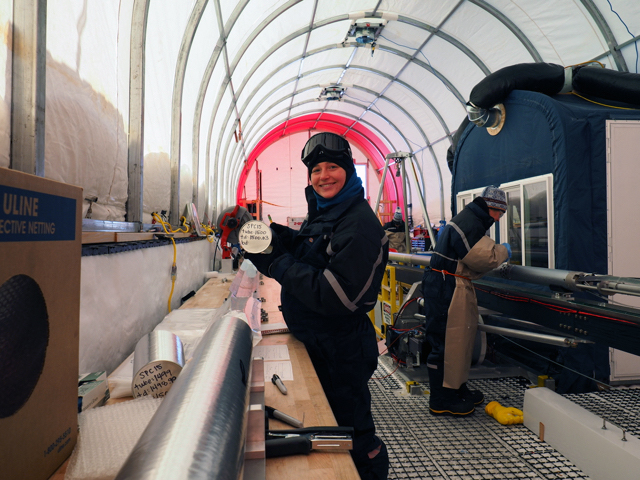
Emma Kahle holding the core tube containing the ice from 1500 meters depth. Photo credit: Eric Steig
Eric Steig arrived at the Pole on Thursday, 07-Jan, and Murat Aydin departed Pole on the same flight. Fortunately, Murat and Eric were able to spend about an hour together sharing notes to ease the transition.
We continued to drill 24 hours a day, six days per week. The workweek ended at 8 PM (three hours early) on Saturday, 09-Jan, with the successful completion of the original 1500 meters depth target! Final depth on 09-Jan was just over 1501 meters. Our average drill rate was about 25 meters/day during the week. At our current rate of drilling, we could reach 1750 meters depth by the end of the season.
We are continuing to drill excellent quality ice, with very clean run breaks. We also continue to collect fugitive gas samples. No cloudy/volcanic layers were seen this week.
Within an hour of sending last week's weekly report, a second conductor in the winch cable shorted to the outer jacket necessitating a cable swap sooner than planned. The original plan was to swap out the 1600-meter long cable with the new 1922-meter long cable some time this week. All in all the earlier-than-planned cable swap went smoothly, however the new longer cable did sustain some damage in the process due to a poorly manufactured spool the cable was sent on from the manufacturer. With guidance from the cable manufacturer, Jay Johnson and crew were able to 'stabilize' the damaged cable and we've had no trouble with the cable subsequently. For more details about the cable, read the attached SITREP from Jay Johnson.
Forty-eight (48) ISC boxes were removed from the ice core storage trench and palletized for shipment to McMurdo Station on Saturday (09-Jan) morning. Combined with the 32 ISC boxes that were palletized last week, there will be 2.5 AFPs of ice going out on a cold-deck LC-130 flight that is scheduled for Tuesday, 12-Jan. This is a total of 80 ISC boxes (tubes 1078 - 1477; depths 1077.99 - 1477.985) consisting of 400 tubes/meters of ductile core that we drilled this season. Earlier in the season, on the evening of 09-Dec, we sent 30 ISC boxes (150 meters) of last year's brittle ice (tubes 585 through 734) to McMurdo Station on a cold-deck LC-130 flight. This brings the grand total for this season's ice retrograde to 110 ISC boxes, containing 550 tubes/meters of core, on 3.5 AFPs.
The weather has continued to be very nice, with calm conditions early in the week, and winds up to ~12 knots later in the week. Outside temperatures have been in the -28°C to -30°C range. The drill tent has seen a range of temperatures from -20°C to -24°C. The core storage trench is close to -34°C.
Everyone is in good health. Most of the crew ski or walk back to South Pole Station from the drill site (about 2.5 miles) at the end of the workday, and/or work out at the gym, so people are keeping reasonably fit.
January 3, 2016
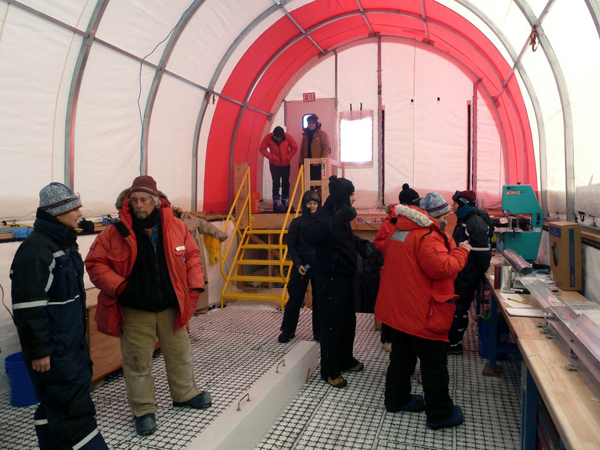
Julie Palais (NSF), Elaine Hood (ASC), Howard Conway (UW), and Michelle Koutnik (UW) visit the drill site. Photo credit: Murat Aydin
We continued to drill 24 hours a day. The workweek started with the night shift on 26-Dec and ended with the mid-shift on 03-Jan. There was a 2-day stoppage (6 shifts) for New Year's. The bottom depth at the beginning of the week was 1211 meters and 1368 meters at the end of the week. There were no major drilling problems except for a brief stoppage due to a problem with the winch motor gearbox (see IDDO SITREP for details). We are continuing to drill high quality ice at a good pace. Cloudy layers are a semi-regular occurrence, with a total of three pronounced layers this week. The fugitive gas sampling continues, with a total of five samples collected thus far.
All of the ice drilled this week has been packed in boxes for retrograde this field season. We are currently at box #58. The first 32 boxes have been taken out of the storage trench, palletized, and moved to our storage area under the old arches at the 'end of the world'. This was necessary to create space in the storage trench for new boxes. The current plan is to have the 2nd load of 32 boxes palletized this coming Tuesday and send all the ice to McMurdo via a cold-deck LC-130 before the end of the week.
Julie Palais, the program manager of the NSF Antarctic Glaciology Program, visited South Pole Station last week. Julie is also the current NSF science representative at McMurdo Station. UW scientists Michelle Koutnik and Howard Conway also arrived on the same plane. They are here for a few more weeks, studying upstream ice flow. Julie, Michelle, and Howard visited the SPICE core camp and saw the drilling and processing of the ice core.
The annual South Pole marathon was held on Saturday, 02-Jan. John Fegyveresi was one of seven people at South Pole Station to complete the 26+ mile course, with Dom and Nick finishing the half marathon. Murat also participated but stopped at around 11 miles.
On Sunday, 03-Jan, the SPICE core team hosted an open house at the drill site and at the back-lit snow pit that John Fegyveresi headed up constructing. The open house was very well attended as many people were interested in learning about our drilling, what can be learned by studying ice cores, and seeing a back-lit snow pit.
Outside temperatures have been in the -24°C to -29°C range. The drill tent has seen a range of temperatures from -20°C to -23°C. The core storage trench remains close to -33°C.
Everyone is in good health.
We anticipate that Eric Steig will arrive to South Pole Station on Wednesday, 06-Jan, to replace Murat Aydin as the science lead. As such we'd like to thank Murat for his outstanding leadership this season.
December 27, 2015
It was another efficient workweek at the South Pole. The highlight of the week was a new visible ash layer observed at ~1180 meters depth. Our resident glaciologist, John Fegyveresi, thinks this could be the thick ash layer observed in the WAIS Divide ice core just before 24 kyr. One interesting point to note is that Ice Cube does not report a visible layer at this depth.
We drilled 24 hours a day, Monday thru Thursday, and then stopped for a 2-day holiday break on Friday and Saturday. The drilling operation resumed on Sunday, resulting in a 5-day workweek. The logger's depth at the start of the week was ~1067 meters and by the end of the week it was ~1211 meters, for a total of ~144 meters of ice drilled during the week. We had a motor section failure at the beginning of the week and have had problems getting the step cutters to penetrate a couple of times, but otherwise the drilling is continuing to progress well (see IDDO SITREP for details).
All of the ice drilled this week has been packed in boxes for retrograde this field season. We are at box #27 as of the end of this workweek. We also completed two fugitive gas samplings on the freshly drilled ice core for PI Jeff Severinghaus. The ice is behaving really well under both the chop and band saws.
The South Pole Station galley held a very nice Christmas dinner, and all three drill shifts were able to attend and enjoy a meal together. On Christmas morning the annual 'Race Around the World' was held and well attended by the SPICE Core team. This year's race was a 2.3 mile course that encircles the geographic South Pole. Congratulations to Shawntel for finishing first in the woman's division and Dom for finishing 2nd in the men's division!
The weather has been nice, as it typically is at the South Pole around Christmas and New Year's. Outside temperatures have been in the -25°C to -29°C range. The drill tent has seen a range of temperatures from -20°C to -24°C. The core storage trench remains close to -35°C.
Everyone is in good health.
December 20, 2015
This week we saw the planned departure of Mindy Nicewonger and the arrival of John Fegyveresi. After much anxiety about whether the flights were going to go as planned, we managed to get John in on the same plane Mindy left on. John will carryout the core logger duties for the rest of the season, taking over Mindy's spot on the night shift. Thanks to John's prior experience, the core handler switchover was effortless. The other highlight for us was the arrival of all our drill fluid. We now have enough drill fluid onsite to carry us through to the end of the field season. Otherwise, it was a relatively quiet and a very efficient workweek here at the South Pole.
We drilled 24 hours a day for most of the week until we experienced a new drill problem very early on Saturday (19-Dec) morning. When the drill motor stopped running, the bottom depth was 1063+ meters (logger's depth from the surface). Most of Saturday was spent trying to identify and solve the problem. It was successful in the end. To everyone's surprise, the problem was not the motor section, but rather the cable that carries power to the motor. A solution was implemented that will hopefully be long lasting (see IDDO SITREP for details). Drilling resumed at around 7pm on Saturday for a few more hours for a final depth of about 1067 meters before we stopped for our one-day weekend.
We continued to drill perfect ice for most of the week. All signs suggest we are out of the brittle ice zone. We conducted a test with the chop saw and did not observe brittle behavior during, or after, the cut. The ice was warmed up to processing area temperatures (about -20°C) before the test to eliminate the possibility that it did not look brittle due to the very cold temperatures when it first comes out of the hole. On Monday (21-Dec) we ended the brittle ice handling/storage procedures, and started cutting and packing the ice core into boxes for retrograde shipment to the USA over the coming weeks. All the ice drilled this past week has been stored on the shelves inside the core storage area for retrograde next field season.
The weather was generally nice this past week, by South Pole standards. No serious visibility issues, and the road to the drill site stayed in pretty decent shape. Outside temperatures have been in the -24°C to -30°C range. The drill tent has seen a range of temperatures from -20°C to -24°C. The core storage trench is close to -35°C.
Everyone is in good health.
December 13, 2015
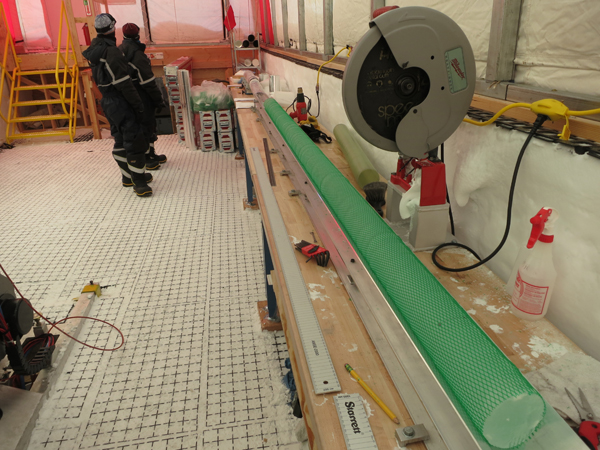
A 1 meter long section of ice core and a 2 meter long section of ice core are matched up on the processing table before the 2 meter long section is cut into two 1 meter long sections using a dry-cut circular saw. The ice shown in this photo is from the 'brittle ice zone'. Because of the potential brittle behavior of this ice, the ice is extruded into (green) plastic netting after it is drilled to ensure that if any breakage of the ice occurs during handling or transport the core fragments will be contained. Photo credit: Murat Aydin
Three-shift drilling operations started this week as scheduled. Despite some problems on Tuesday (12/8) and Wednesday (12/9), mostly related to the drill motor, the first week of the drilling operation has been quite successful. We drilled just about 142 meters of ice in 6 days. The bottom depth of the hole is currently at 885 meters. The one big outstanding issue is the lack of drill fluid at the site. Despite efforts by many parties, we have not been able to get a drill fluid shipment to South Pole this year yet. There were four full barrels and one partial barrel left at Pole from last season, all of which we have already used for this year's drilling. The remaining drill fluid is in McMurdo, and has been listed as priority one cargo since 11/30, but has yet to arrive.
We sent back 30 boxes (150 meters) of ice (tubes 585 through 734) to McMurdo on a cold deck LC-130 flight on Wednesday (12/9) evening. All 150 meters of the ice was drilled last season and stayed at the Pole during the past winter. Tube 735, which was also drilled last year, will be kept at the Pole for another year because it will be necessary at the start of core logging next season.
Processing of the newly drilled (e.g. drilled this year) brittle ice continues. We are netting, measuring, and placing the ice in 2 meter tubes for winter over in the core storage trench. Nearly all the ice is excellent quality. No obvious signs of brittleness during netting and measurements.
Outside temperatures have climbed up to -19°C for a day. They are now in the -25°C to -29°C range. The drill tent has mostly been between -20°C to -22°C, except for when it was -18°C and -19°C on Tuesday (12/8). The core storage trench is at -33°C.
December 6, 2015
Drilling started yesterday (Saturday, December 5) after spending a modest amount of time on fixes, reaming, and baling during the week. On the first day of drilling (only one shift), we drilled about 12 meters of ice. The hole depth by the end of the day yesterday was 748.00 meters according to the logger's notes. We are not working today (Sunday). Drilling will resume Monday in three shifts as planned.
The packing of all of the leftover ice from last year (118 meters + 33 meters for a total of 151 meters) is finished. The green netting was kept on the ice as it was cut into 1 m pieces and packed in core tubes. 150 meters of the ice (30 boxes) have been taken out of the trench, banded on wood skids, and netted on an air force pallet. The last meter of ice from last year will stay at the Pole because it will be needed at the start of next year's logging operation for index mark purposes. We received a lot of help from South Pole cargo to get the ice flight ready. The first ice shipment of the season is now ready for delivery to McMurdo.
Outside temperatures are in the -28°C to -32°C range. Wind chills are very variable. The drill tent has been -22°C to -24°C. Core storage trench is -35°C.
We had a dose of really bad weather on Thursday, December 3, with wind gusts topping 25 knots. Low clouds made visibility worse. Driving to and from the site under such conditions is proving to be a challenge. More bad weather expected to start next week.
Dr. Mike Jackson, our NSF representative, was at South Pole Station for a few days this week. He visited the drill site a couple of times to meet everyone, learn about ice core drilling, see how our operation works, and even help out processing core.
November 29, 2015
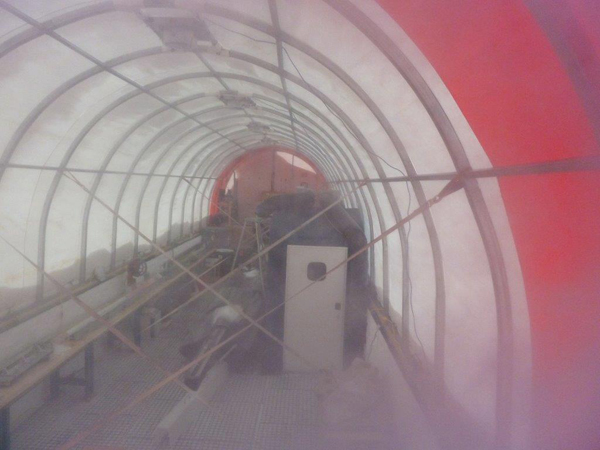
Photo of the inside of the drilling tent after its first winter-over at the South Pole. Photograph By: Marissa Goerke, National Science Foundation
We arrived at the South Pole around 9 pm on Wednesday, November 25. All the camp structures were set up at their summer locations prior to our arrival. The generators were at the station and getting prepped for the season. We all received vehicle training on Thursday morning and got assigned the wheeled van. In our first visit to the drill site, we found the drill tent and the storage trench in great shape. No obvious structural deterioration. The ice that stayed in the storage trench during the winter looks to be in great shape as well. Our 'do not freeze' (DNF) cargo and the generators were out at the site by the end of Friday before the 2-day Thanksgiving break at the station. Having the MECC warmed up allowed us to go out to the site and do some organizing and set up during the long weekend. As usual, the Thanksgiving dinner at the station was top notch. Everyone overate and looked happy.
November 23, 2015
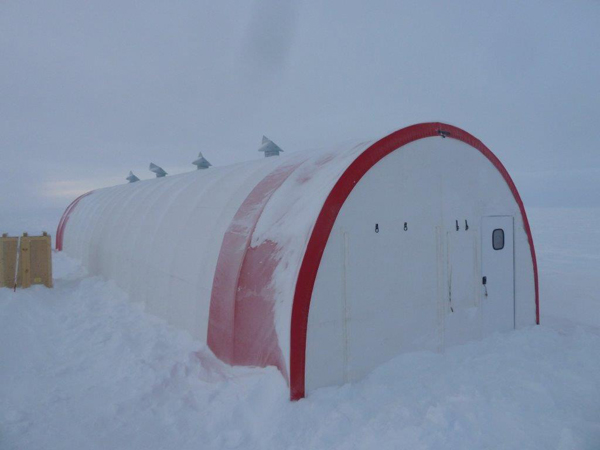
Photo of the drilling tent after its first winter-over at the South Pole. Photograph By: Marissa Goerke, National Science Foundation
The field season has started. There has not been any real field activity since we have not yet arrived at the South Pole. All 10 members (3 science, 7 drillers) of the group arrived in McMurdo Station, Antarctica, on November 22, 2015 with one extra day of layover in Christchurch, New Zealand, due to weather conditions in McMurdo. Current McMurdo temperatures are very reasonable considering what is waiting for us at the Pole. The outside temperatures are in -6°C to -4°C range. The SPICE core team and the firn project (1-191-S) members are together and acting as one team. On November 23, 2015 our flight to the South Pole was scheduled as a backup mission to three other intercontinental missions; all three intercontinental missions flew so we didn't fly to the Pole. Between the second and the third tries, we had a nice climb up Observation Hill. We have been rescheduled as a primary mission to the Pole on November 24, 2015.
2014/15 Antarctica
February 1, 2015
We concluded our successful season with winterizing the camp. Everything went smoothly. The brittle ice is relaxing in the storage trench. The drill tent is braced inside with cargo straps. The buildings were pulled to the resting spots. The cargo is up on 6-foot high spools to minimize drifting. And everything out at the site got inventoried.
We arrived in McMurdo on Friday night and spent the weekend enjoying the abundant oxygen and warm temperatures at sea level. We are scheduled to depart for Christchurch on Monday, February 2. This is the last SITREP of the season.
January 25, 2015
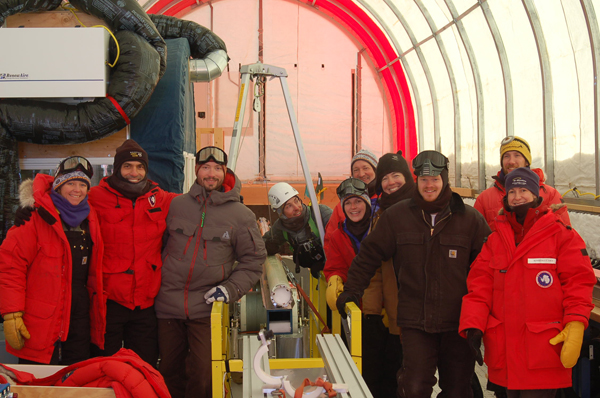
Group picture after drilling/collecting the first ice core with the Intermediate Depth Drill. Photo credit: Mindy Nicewonger.
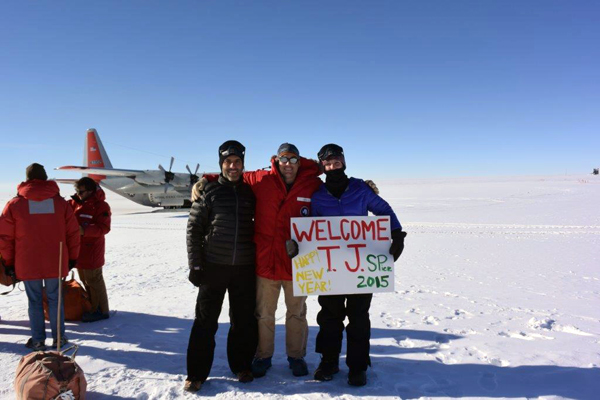
(L to R): Murat Aydin, T.J. Fudge and Mindy Nicewonger in front of a U.S. Air Force LC-130 Hercules. Photo credit: Leah Street
We had another successful week, and a successful season, of drilling. We reached our season goal of 700 m on Thursday morning and then concluded drilling at 736 m on Saturday morning. We spent the final shift on Saturday bailing the hole of chips.
The second cold deck occurred on Friday with the ice arriving before the vessel docked in McMurdo. The folks at Pole and beyond did a fantastic job prioritizing the cold deck despite pressure from many directions due to the many canceled flights this week.
We have 150 m of ice resting in the storage trench. Most has been netted but it would be unfair to call it "brittle" as there are few fractures.
We have begun drying the drilling sonde and packing up. Next week we will prepare retro cargo and winterize the camp. We hope to depart the Pole on Friday, January 30th and the continent on February 3rd after a long and successful season.
January 18, 2015
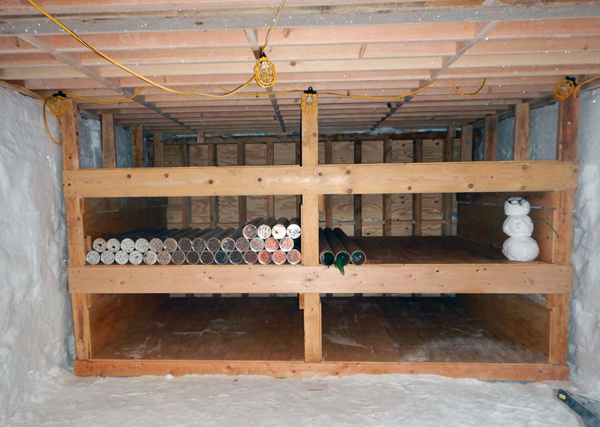
Inside the core storage trench. The trench serves as a storage area for all of the drilled ice until it is ready to be flown from South Pole Station to McMurdo Station. In addition, all of the ice from the 'brittle ice zone' is stored in the trench over winter to provide more time to relax internal stresses before the ice is shipped back to the United States. Shown here is the shelving system used for storing the brittle ice over winter. Photo credit: T.J. Fudge
We have had another productive week. We drilled 160 m, reaching a depth of 624 m. We packed to 585 m depth for the second cold deck of the season and will send back the maximum amount of ice possible in the Safecore container. Unfortunately, the cold deck flight was canceled and has been rescheduled for Monday afternoon. The pallets of ice are resting under an unused steel arch. The arch provides good shade and acts as a wind tunnel. The outside temperatures have been about -28C.
We declared the start of brittle ice at 619 m after a core fractured all the way through for the first time. We are packing all ice in netting and letting it rest in 2m sections on the storage racks in the trench. We have one more week of drilling before winterizing the drill camp and heading North.
January 11, 2015
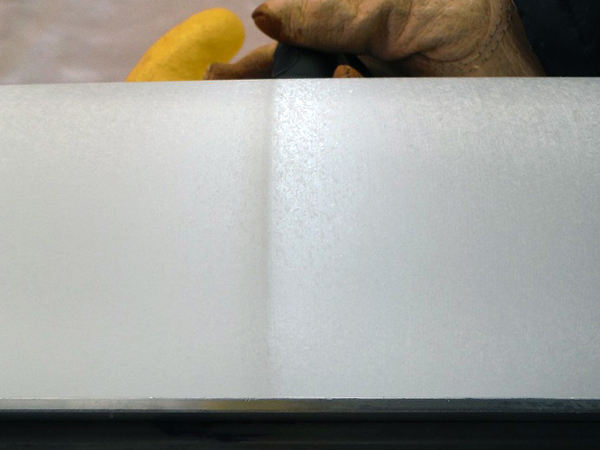
The first visible tephra (volcanic ash) layer in the ice core. The tephra layer is at approximately 306.5 meters depth. Photo credit: Mindy Nicewonger
The past week has been very productive. In the 8 days since the last day off, we drilled 200 m of core, reaching a depth of 460 m. We also sent two full pallets, 320 m of ice, on a cold-deck flight to McMurdo. Murat accompanied the ice on his way home after a productive overlap period with T.J.
The drilling has become more routine as challenges with the bearing and anti-torque slips have been mitigated. The fabrication of step cutters improved the coring quality and speed. A second set of step cutter with a small design change reduced the ribbing on the core surface.
The ice remains high quality. It is becoming more brittle, but with only a few exceptions, remains excellent-to-very-good. The next cold-deck flight is scheduled for 15-Jan, in time for the ice to be loaded on the vessel in the Safecore container. We currently have about 160 m of ice packed for the next cold-deck flight. Whether we reach the full capacity will depend on whether the ice becomes brittle and when the cold-deck happens. We have also decided to build the brittle ice storage racks before the storage trench becomes too full of ice.
All in all, a long but productive week. We have two weeks of production drilling remaining before winterizing camp for next year.
January 4, 2015
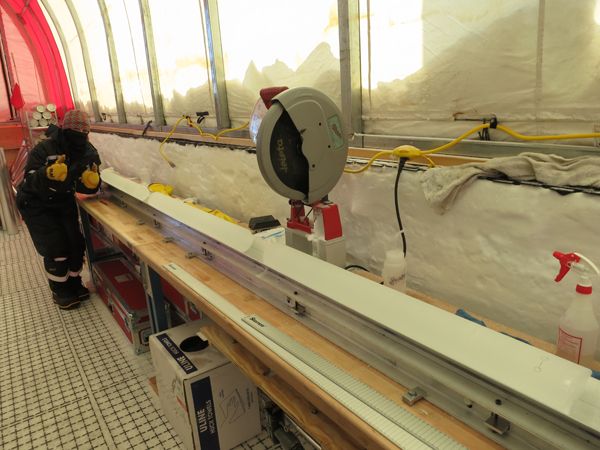
Mindy Nicewonger at the core processing station inside the drill tent. The drill recovers ice cores approximately 2-meters in length. The 2-meter long sections of core are then cut into 1-meter long sections so that they fit into the standard-sized insulated shipping container (ISC) boxes used by the US ice-coring community to transport ice cores. A dry-cut circular saw is used to make the cuts. Photo credit: Murat Aydin
We welcomed the New Year in good spirits and with a storage trench full of core. We celebrated New Year's on the 2nd with a well deserved day off, but were back at it on the 3rd despite the station enjoying another free day. T.J. arrived just in time to see a beautiful 2m core before the celebrations began.
We have reached a depth of 309 meters and recorded our first visible ash layer at 306.5 m. We are consistently drilling 2m long sections of excellent-to-very-good core. The drilling requires care to minimize anti-torque slips and lots of sharpening of cutter and core-dog blades.
A cold deck flight is scheduled for tomorrow (Jan 5, local time) and Murat will accompany the flight as he begins his trek back north. We will send the maximum 64 core boxes and 320 m of core on the flight. This will not quite empty the storage trench, but it will give us back space for packing the new core being drilled. We will also take advantage of the space to level the floor in preparation for the construction of shelves to hold the brittle ice.
December 28, 2014
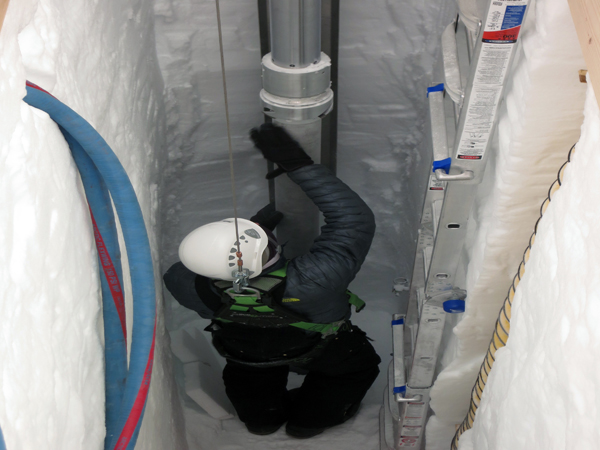
Reaming of the dry drilled borehole. The dry drilled borehole is reamed to a larger diameter in order to install/set the borehole casing needed for the wet drilling. Photo credit: Murat Aydin
The big news of the week is Estisol, of course, what else? The reaming and the casing went very smoothly and the switch over to fluid drilling have taken only 4 workdays. Once we started to drill again, we realized that some of the problems disappeared. The core breaks are now much better, with three dogs engaging most of the time. Getting the cores out of the barrel is very easy. That is one thing a lubricant like Estisol is great for. The FED is not perfect but it provides a good start in drying the core. A wipe with an Isopar soaked towel, followed by a wipe with a dry absorbent towel appears to get rid of most of the Estisol. The bad news is we are having to stop the runs way short of the ideal 2 m lengths because of either anti-torque (AT) slips or amp-outs on the cutting motor (more frequently AT slips). We are also having occasional seize problems with the bearing that attaches the cable to the drill.
So far, a perfect cure it all solution has eluded us. The leading theory is that poor chip transport might be the root cause of most problems. There are some potential solutions on the table that we will try. We can also use a little bit of luck at this point. The hope is that TJ is bringing some with him.
Now on to more light hearted news. Andy Clarke from NOAA gave a science lecture this Sunday that included a lot of climate change related material. The station population has been very receptive to our message in general. Wining people over one at a time.
December 21, 2014
This has been another up and down week. Monday started out with some new electronic problems, this time relating to the cutter head control. It was possible to find a work around as before and we were able to get 20+ meters of core in one shift. We were getting ready to switch to two shifts if things went smoothly on Tuesday but we had another problem. This one was self-inflicted. After a series of unfortunate events, the drill cable snapped. Luckily, the drill was at the surface, and after an initial scare, we found out the damage was not nearly as bad as it could have been. We were up and running again by Wednesday, but this time some drilling problems emerged that impacted the drilling efficiency and core quality. There were two major problems. First, the drill was rattling a lot during the trips, which meant we had to decrease the trip speeds down to a crawl. Second, we started having serious issues with core breaking. The dogs were getting sintered in with chips and not wanting to engage, which often resulted in one-dog core breaks. This appeared to result in long spalls. After a couple of days of battles, it was figured out that the rattling was due to a problem with the anti-torques and it was resolved to the best of our ability. We also did the first ream to improve the quality of the hole walls. This is something that had to be done anyway before we could start the fluid drilling. These two measures fixed the rattling problem and we tried to continue dry-drilling on Saturday. Unfortunately, we could not overcome the chips mucking up the drill head problem and decided to call it on dry-drilling early afternoon on Saturday. We had just over 160 m of core at that point.
After the decision was made to stop dry-drilling, the second reaming, with a 7″ reamer if I'm not mistaken, started Saturday afternoon. We also decided to start the two shifts. The first night shift went out to continue reaming on Sunday night (21st) around 10pm. A 9″ ream will follow the 7″ one, and after that we'll need about a day to case the hole. It appears this year's Christmas present will be Estisol. We estimate that the production of fluid drilled cores will start on Christmas Eve. Let's see if we can keep that promise.
This is supposed to be the highlights section so here is a highlight of the week. The station welcomed a congressional delegate on Friday, after two days of flight delays. All in all, they spent a little more than 2 hrs. at the Pole, which did not include any time with the SPICE project.
December 14, 2014

Group picture after drilling/collecting the first ice core with the Intermediate Depth Drill. Photo credit: Mindy Nicewonger
The drilling of the main SPICE core borehole started this week. Most of the final preparations were completed on Monday before lunch. Following a little more fine tuning after lunch, the drilling started. We were somewhat apprehensive about core recovery in the shallow firn because of the sugar layers we saw while the trench was being dug. As it turned out, the core dogs performed pretty good even in the shallow firn. Some of the dog marks on the first cores were more than a few inches long but there did not appear to be any real danger of not bringing the core up. Finished Monday on a happy note with a small celebration in the MECC.
Tuesday started out fine as we quickly got down to 20+ meters before lunch. When we came back form lunch, however, we found the drill out of commission. The drillers reported nothing on the control console was working: could not control the winch and could not turn the cutters either. Looked like the board in the control console was fried. The drillers installed the spare, which fixed some of the issues. Cutters were spinning and we had tripping control on the winch, however, still no fine (drilling) control on the winch. We spent most of the week (Tue afternoon through Friday afternoon) trying to fix the problem. At one point, James Roth, an electronic savvy guy (relative to us) who is a going to deploy at WISSARD later this season, put together a hybrid board using what was thought to be good parts from the two boards that malfunctioned. Unfortunately, the hybrid board also failed as soon as it was installed. On Thursday, IDDO sent us a work around plan. By Friday afternoon, the work around (bypassing the malfunctioning board and controlling the winch directly via the pots on the console) was implemented and perfected. Drilling started again Friday afternoon. We had a very productive day on Saturday, drilling about 42 m. We still do not know what was killing the boards (more specifically the problem seems to lie with the op-amps on the boards). There is likely a short (or something of that nature) somewhere but we haven't been able to locate it. We considered static as a potential cause and started to ground whoever is working with the console. The good news is the workaround solution works great. We are drilling very efficiently and the core quality has been excellent through the top 84 m of the firn. No problems so far with core getting stuck in the barrel as it did in Greenland while dry-drilling firn cores. We do have some spare boards and op-amps in the mail, however, we do not plan on trying to install them immediately.
December 7, 2014
This past week was spent getting everything ready for drilling. Everything we need in the drill trench for fluid drilling is ready, including all the ventilation components that were added after the Greenland test. A lot of time went into preparing the drill control room. The storage trench is also just about ready. The wall and roof installation was completed. We settled on the stairs solution to access the storage trench. The original drawings had a ramp but the beginning of the ramp was going to be too close to the drill when the tower was down. Moving the ramp into the storage trench was causing head clearance issues at the entry. The sugar snow was an additional concern. It is very hard to pack it and get a nice solid surface. I think the stairs will work better in the end and save us some valuable space inside both the drill and storage trenches.
Probably, the biggest news of the week is the recovery of two 10m deep hand auger cores on Saturday. We have our first 4 boxes of ice cores. A few things to note on the core tubes and boxes: Core tubes can only accommodate up to 105 cm and the core boxes can only accommodate 5 tubes. The sixth tube pushes the top insulation up and the boxes don't want to close properly. However, having only 5 tubes leaves some empty space at the top. We put snow in this leftover space when we packed the hand cores. We intend to do the same for the actual cores from our main hole.
This week we also got our vehicle situation sorted out. We've been using two snow machines to go back and forth but we kept having problems starting one of the machines (this is a very common problem at South Pole) and ended up crowding on to one people mover. They finally got the parts to fix the wheeled van this week and now we are in really good shape for the commute.
November 30, 2014
We made some real progress this week. The generators at the site were started on Monday, allowing us to warm up the MECC, which was needed to do any serious work out there. The real turning point for the project was the meeting on Tuesday (Nov. 25th) between parties from the NSF, the ASC, and the IDDO. We got the final green light. The rest of the day was spent laying geoblock and making saw cuts for the trench excavation. Tanner and I decided November 25th is our official construction start date. On Wednesday, the excavation of the drill trench was completed and one end-wall (opposite to the storage trench side) was in and back-filled. Spent Thursday working on the skeleton of the drill trench structure. By Friday morning, the tent was ready to be moved over the trench. This pretty tricky job was completed successfully before lunch break on Friday. Both the IDDO and the ASC crews were right on. We went to work on Saturday (the station was taking the day off due to Thanksgiving) to start sorting out the inside of the drill trench.
There were other notable activities. Kimberly did some experiments on the runway (see details in the others section).
The South Pole traverse arrived at 8pm on Wednesday. We determined that the potential firn site for the 15/16 field season was not ideal. Given that the proximity of our drilling location to the old station, we asked the traverse folks to do a GPR survey of the new potential firn drilling area. This was completed on Saturday the 29th. They did a 10 m x 10 m grid of a 100 m x 100 m area and did not see anything. Kimberly has all the details and the data.
I gave a science lecture to the station on Sunday evening, providing a general overview of the SPICE project and some specifics on the scientific objectives from a trace gas perspective. I also promised TJ would give a talk about the isotopes and climate side of the project when he arrives in January.
November 23, 2014
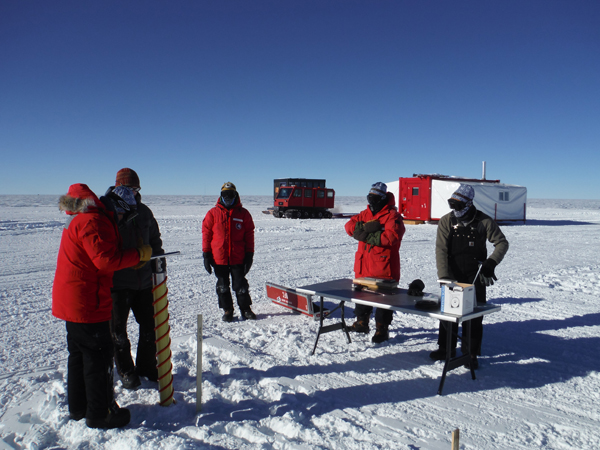
Drilling one of six shallow cores at the drill site. The purpose of the shallow cores is to measure the snow density at the drill site to make sure that it is adequate for the overlying drill structure. Photo credit: Murat Aydin
This week was definitely more eventful than the previous one. The MECC and the Duke (a spacious relief facility) are at the site and set up. The generators have arrived and been prepared. They are scheduled to go out to the site on Monday the 24th. The snowmobiles are ready and the van is getting there. Some of the cargo has been dragged out to the site. Most importantly, we finally got the green light from NSF design and safety team to move forward, with the understanding that the safety of the drilling operation is the responsibility of IDDO. There is also progress on the design of the trench roof. There is going to be a meeting between ASC and NSF on Monday 24th (US time) about the 90% drawings. It was disappointing that another week went by without construction at the site but it seems imminent. ASC is aware that we want the operation to start already and all signs indicate we will break ground this week.
There was a visit from a group of Russians, including the head of Russian NSF, to the station. Apparently, they are looking into upgrades to Russian Antarctic stations using some private money. The SPICE group is receiving high praise from station management for their contributions to station operations. They are not sitting around idle because we don't have much to do for our project. IDDO should ask ASC to chip in for the drillers' wages. In their spare time, the group visited the ARO building, the South Pole telescope, and the Spud/Keck telescope, and took some group pictures at the ceremonial Pole. We're ready to go.
November 16, 2014
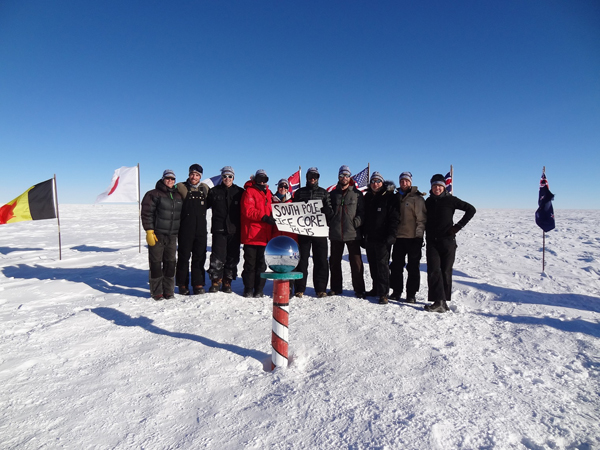
The 2014-15 South Pole ice core field team at the Ceremonial South Pole. (L to R): Elizabeth Morton, Grant Boeckmann, Nick Wipperfurth, Mindy Nicewonger, Kimberly Casey, Murat Aydin, Tanner Kuhl, Dave Ferris, Josh Goetz and Shawntel Singleton. Photo credit: Dave Ferris
The highlight of the week is the record breaking travel time for Murat, Mindy, and Kimberly, spending less than 36 hrs at CHC and about 18 hrs night at MCM. The whole team got their snow mobile and light vehicle training. Kimberly successfully turned on the one spectrometer that got here in the science lab. Other than that, it has been more of a lowlight week. No cargo movement to NPX worth mentioning, although most or all cargo should be in MCM. There is the outstanding NSF safety stamp issue.
